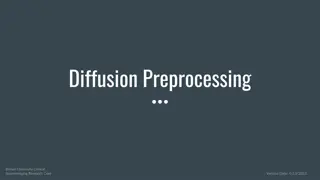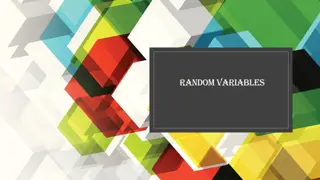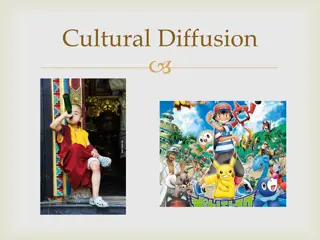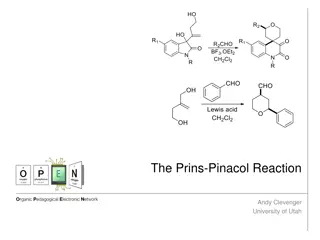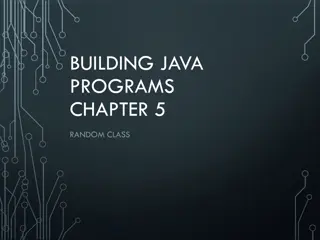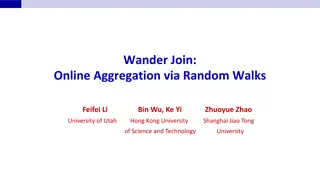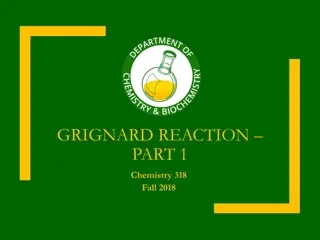Exploring Reaction-Diffusion Systems and Random Walks in Chemistry
Delve into the fascinating world of reaction-diffusion systems and random walks in chemistry, exploring concepts such as well-mixed reactive systems, diffusion-reaction dynamics, finite differences, and incorporating reactions into random walks. Discover how these principles play a crucial role in understanding complex chemical interactions and spatial dynamics.
Uploaded on Sep 07, 2024 | 0 Views
Download Presentation

Please find below an Image/Link to download the presentation.
The content on the website is provided AS IS for your information and personal use only. It may not be sold, licensed, or shared on other websites without obtaining consent from the author. Download presentation by click this link. If you encounter any issues during the download, it is possible that the publisher has removed the file from their server.
E N D
Presentation Transcript
Reaction-Diffusion Systems Reactive Random Walks
General Principle Consider a reactive system made up of species A, B and C, where A and B can react to form C at some rate kf and C can degrade back into A and B at some rate kb kf kb If the system is well-mixed (i.e. no spatial variability in concentration,reaction are governed by the law of mass action
Lets Start Simple Recall Chemistry 101 A C B
Question Consider a case where you have equal amounts of A and B initially, that is CA(t=0)=CB(t=0)=C0 and no CC. What will the system evolve to at very late (steady state) times? What is kb=0, i.e. there is no backward reaction. How will the system evolve at all times? at late times
Diffusion-Reaction System Now, rather than assuming that the system is well mixed, we allow A, B and C to move through space by diffusion, but they still react by the law of mass action How can you solve these equations?
Certainly Finite Differences Explicit forward in space and time difference equation: Works, but certain issues such as stability and numerical dispersion can be exacerbated
How about random walks Recall So, let s break A into N particles and B into N particles and let them bounce around randomly as we have done before We know this solve the diffusion equation, but how to include reactions? What is needed?
Let start with the easier case CC CC is degrading a first order rate kb. Do you remember how to incorporate this into the random walk method. Calculate the probability of reaction during any given time step Generate a random number Q, drawn from a uniform distribution U[0,1]. Reaction does not occur Reaction occurs
Conceptual Picture How about for the bimolecular reaction A+B->C. Consider an A and a B Particle, distributed in space All we know is the location of these two particles at time t, their diffusion coefficient and the reaction rate kf. (xA,yA) How do we calculate the probability of reaction for this pair in the same way as we did in previous slide. Brainstorm it! And think about what has to happen for a reaction to occur (xB,yB)
Several Approaches Exist Fixed (Hard) Radius Method If particles are less than a distance rcrit they have probability 1 of reacting. Question : How do we determine rcrit and make it physically consistent with what we know about A, B and C move? Variable (Soft) Radius Method Particles have a probability of reacting depending on how far apart they are as long as they are within some critical radius. Again, how do we determine this? Which do you prefer?
Neither and either did my mate Dave Benson & Meerschaert Algorithm Move Particles with a random walk Based on the distance between two particles calculate probability that they will collocate Then based on the reaction multiply probability that reaction will occur B A
This is the cool idea Probability of Reaction Depends only on transport = Probability of Collocation Depends only on reactions X Probability of Reaction Given Collocation But what are they?
Consider a 1d system An A particle is located a position x1 and a B particle is located at a position x2 at time t as depicted. What is the probability they will collocate at time t+ t. Consider how they move. Where will they be located at time t = t s=x2-x1 x 2 x1
Consider a 1d system At time t+ t, each particle s random position is described a Gaussian (i.e. solution of diffusion equation) x 2 x1 s=x2-x1
Consider a 1d system At time t+ t, each particle s random position is described a Gaussian (i.e. solution of diffusion equation) x 2 x1 s=x2-x1 Overlap area gives probability of collocation
Probability of Collocation Probability of Collocation Calculate integral directly or in Fourier Space (convolution rule)
What about Probability of Reaction given collocation This is easier Where kf is reaction rate mp is the mass of a particle t is time step
Step 1 Move Particles by Brownian Motion Update Particle Positions by x(t+dt)=x(t)+sqrt(2Ddt) Random Jump Reflecting Diffusion
Step 1 Move Particles by Brownian Motion Update Particle Positions by x(t+dt)=x(t)+sqrt(2Ddt) Random Jump Reflecting Diffusion
Step 1 Move Particles by Brownian Motion Update Particle Positions by x(t+dt)=x(t)+sqrt(2Ddt) Random Jump Reflecting Diffusion
Step 2 Search for Neighbors of Opposite Particle Particle 1 Gives distances s1 s2 s3
Step 3 Calculate Probability of RXN Particle 1-1 Probability of Reaction = function of distance and diffusion Probability of Collocation X Probability of Reaction Given Collocation function of reaction kinetics
Step 4 Die or Survive Generate a random number 0<P<1 Particle 1 - 1 If P< Probability of Reaction Kill both particles If greater move to next blue particle For this example let s assume greater
Step 4 Die or Survive Generate a random number 0<P<1 Particle 1 - 2 If P< Probability of Reaction (for this pair) Kill both particles If greater move to next blue particle For this example let s again assume greater
Step 4 Die or Survive Generate a random number 0<P<1 Particle 1 - 2 If P< Probability of Reaction (for this pair) Kill both particles If less move to next blue particle Let s assume less now
Step 4 Die or Survive Generate a random number 0<P<1 Particle 1 - 2 If P< Probability of Reaction (for this pair) Kill both particles If less move to next blue particle Let s assume less now And so on Cycling through all blues
Repeat for Each red Particle Particle 2 And so on Cycling through all reds Then back to Step One (Move Particles)
The grand question How do you code this? - Next Lecture



